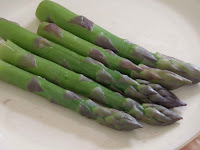Efficiency in the garden is a subject I think a lot about through the winter. The ideal is a perfectly tended set of beds that rarely, if ever, lies fallow and is always producing something edible. This ideal seems so simple while leafing through the garden books and catalogues tucked away in a warm corner chair. My well intentioned seasons in the garden end up as haphazard as planned, but at least there is a plan. The plan at the moment involves trying out winter greens so that next January there will be leafy crunchy things to pick out of the snow and put in a pot for dinner. Winter greens have never really made it onto my table though, so the past couple months we've been trying them out to see which is tastiest. The winner is kale.

Collard greens, mustard greens and kale both belong to the "cabbage" family, the Brassica genus, which includes broccoli, Brussels sprouts, cauliflower and cabbage. Kale has the classic blue-green leaves of cabbages, and was actually a staple of the common European diet until the middle ages when the more tender and compact cabbage was bred. The richly dark and frilly leaves of kale are stunningly nutritious, with high levels of Vitamin A and C, and calcium. It is widely available in a variety of markets and often the crispest looking green around in January.
Cooking kale is outrageously simple. Remove washed leaves from the tough stems and toss in a pot with about half an inch of lightly salted boiling water then cover and steam for 10 to 15 minutes. The greens wilt down a little like spinach, but there is a hearty flavor and backbone left to the kale. I was expecting a bitter flavor, which I found in the mustard greens we tried, but was surprised just how tasty and tender the kale was. Although most cookbooks I referenced were largely silent on the subject of cooking greens, collards and kale, the cooking times I found varied widely, up to an hour in some recipes. Starting at the minimum of 10 with my first batch of kale, I liked it so much I did not try any longer cooking. It strikes me that kale leaves chopped would be a lovely addition to rustic winter soups and would stand up well to an extended simmer.
 Ah, the voluptuous peach, its fuzzy skin so soft and inviting to the touch. Not bright and brassy like the apple, the peach has a warmth to it, a sensuality. Its shape is alluring: a round swell ringed by a delicate crease with a single dimple for the stem at the top. The crease suggests where to run a knife to slice the peach into perfectly mirrored halves of gold, blushing red where where the pit is touched. Each bite is a melting gush, the flesh so full of juice and sweet. A delightful mess to eat, peaches leave me with wet fingers and a sticky dribble on my chin.
Ah, the voluptuous peach, its fuzzy skin so soft and inviting to the touch. Not bright and brassy like the apple, the peach has a warmth to it, a sensuality. Its shape is alluring: a round swell ringed by a delicate crease with a single dimple for the stem at the top. The crease suggests where to run a knife to slice the peach into perfectly mirrored halves of gold, blushing red where where the pit is touched. Each bite is a melting gush, the flesh so full of juice and sweet. A delightful mess to eat, peaches leave me with wet fingers and a sticky dribble on my chin.
















